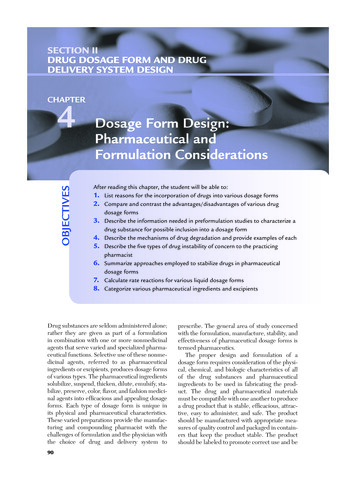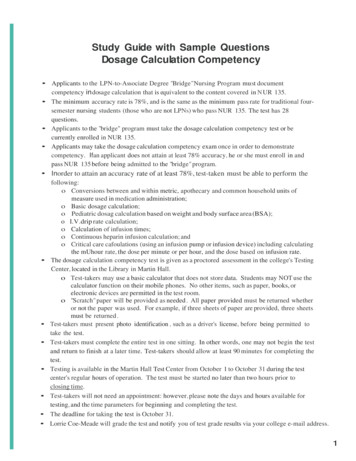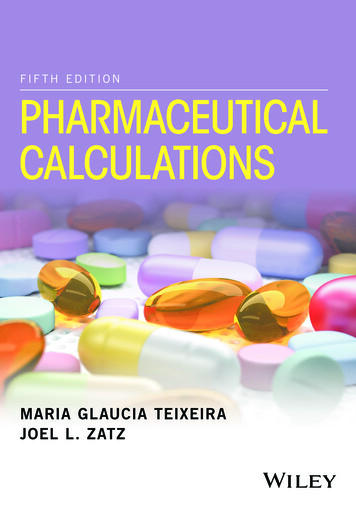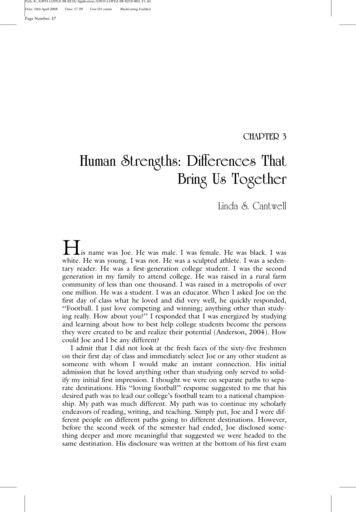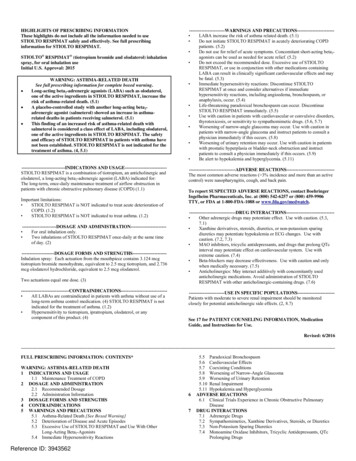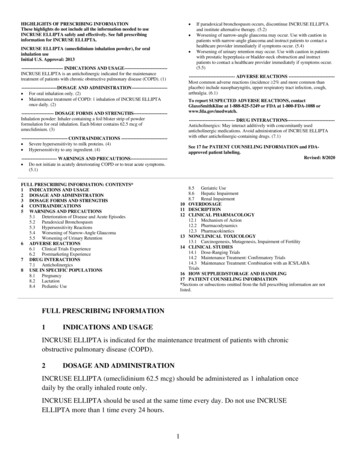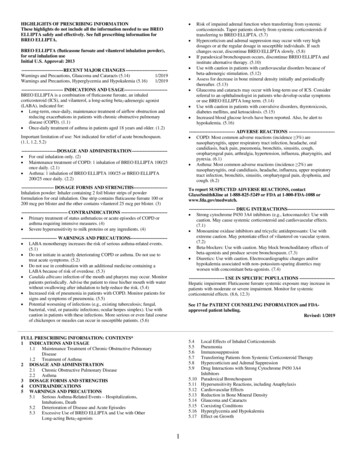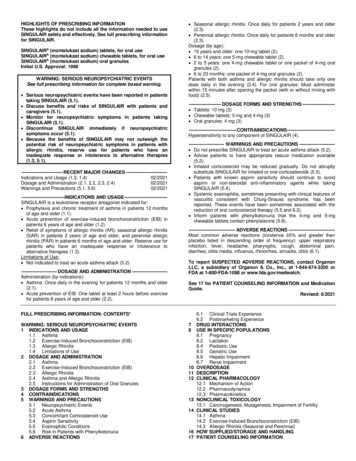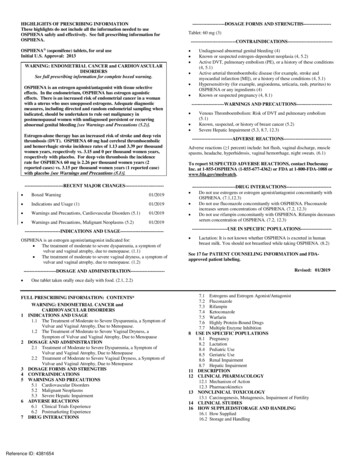
Transcription
HIGHLIGHTS OF PRESCRIBING INFORMATIONThese highlights do not include all the information needed to useOSPHENA safely and effectively. See full prescribing information forOSPHENA. OSPHENA (ospemifene) tablets, for oral useInitial U.S. Approval: 2013WARNING: ENDOMETRIAL CANCER and CARDIOVASCULARDISORDERSSee full prescribing information for complete boxed warning.OSPHENA is an estrogen agonist/antagonist with tissue selectiveeffects. In the endometrium, OSPHENA has estrogen agonisticeffects. There is an increased risk of endometrial cancer in a womanwith a uterus who uses unopposed estrogens. Adequate diagnosticmeasures, including directed and random endometrial sampling whenindicated, should be undertaken to rule out malignancy inpostmenopausal women with undiagnosed persistent or recurringabnormal genital bleeding [see Warnings and Precautions (5.2)].Estrogen-alone therapy has an increased risk of stroke and deep veinthrombosis (DVT). OSPHENA 60 mg had cerebral thromboembolicand hemorrhagic stroke incidence rates of 1.13 and 3.39 per thousandwomen years, respectively vs. 3.15 and 0 per thousand women years,respectively with placebo. For deep vein thrombosis the incidencerate for OSPHENA 60 mg is 2.26 per thousand women years (2reported cases) vs. 3.15 per thousand women years (1 reported case)with placebo [see Warnings and Precautions (5.1)].-------------------------RECENT MAJOR CHANGES------------------------ Boxed Warning01/2019 Indications and Usage (1)01/2019 Warnings and Precautions, Cardiovascular Disorders (5.1)01/2019Warnings and Precautions, Malignant Neoplasms (5.2)01/2019 ---------------------DOSAGE FORMS AND STRENGTHS----------------- Tablet: 60 mg --------------------------- ---------------------WARNINGS AND PRECAUTIONS---------------------- Venous Thromboembolism: Risk of DVT and pulmonary embolism(5.1)Known, suspected, or history of breast cancer (5.2)Severe Hepatic Impairment (5.3, 8.7, 12.3) --------------------------ADVERSE REACTIONS------------------------------ Adverse reactions ( 1 percent) include: hot flush, vaginal discharge, musclespasms, headache, hyperhidrosis, vaginal hemorrhage, night sweats. (6.1)To report SUSPECTED ADVERSE REACTIONS, contact DuchesnayInc. at 1-855-OSPHENA (1-855-677-4362) or FDA at 1-800-FDA-1088 -DRUG INTERACTIONS---------------------------- Do not use estrogens or estrogen agonist/antagonist concomitantly withOSPHENA. (7.1,12.3) Do not use fluconazole concomitantly with OSPHENA. Fluconazoleincreases serum concentrations of OSPHENA. (7.2, 12.3) Do not use rifampin concomitantly with OSPHENA. Rifampin decreasesserum concentration of OSPHENA. (7.2, 12.3) -----------------------USE IN SPECIFIC POPULATIONS------------------- -----------------------INDICATIONS AND USAGE--------------------------- OSPHENA is an estrogen agonist/antagonist indicated for: The treatment of moderate to severe dyspareunia, a symptom ofvulvar and vaginal atrophy, due to menopause. (1.1) The treatment of moderate to severe vaginal dryness, a symptom ofvulvar and vaginal atrophy, due to menopause. (1.2)Undiagnosed abnormal genital bleeding (4)Known or suspected estrogen-dependent neoplasia (4, 5.2)Active DVT, pulmonary embolism (PE), or a history of these conditions(4, 5.1)Active arterial thromboembolic disease (for example, stroke andmyocardial infarction [MI]), or a history of these conditions (4, 5.1)Hypersensitivity (for example, angioedema, urticaria, rash, pruritus) toOSPHENA or any ingredients (4)Known or suspected pregnancy (4, 8.1) See 17 for PATIENT COUNSELING INFORMATION and FDAapproved patient labeling.Revised: 01/2019---------------------DOSAGE AND ADMINISTRATION--------------------- One tablet taken orally once daily with food. (2.1, 2.2)FULL PRESCRIBING INFORMATION: CONTENTS*1234567Lactation: It is not known whether OSPHENA is excreted in humanbreast milk. You should not breastfeed while taking OSPHENA. (8.2)WARNING: ENDOMETRIAL CANCER andCARDIOVASCULAR DISORDERSINDICATIONS AND USAGE1.1 The Treatment of Moderate to Severe Dyspareunia, a Symptom ofVulvar and Vaginal Atrophy, Due to Menopause.1.2 The Treatment of Moderate to Severe Vaginal Dryness, aSymptom of Vulvar and Vaginal Atrophy, Due to MenopauseDOSAGE AND ADMINISTRATION2.1 Treatment of Moderate to Severe Dyspareunia, a Symptom ofVulvar and Vaginal Atrophy, Due to Menopause2.2 Treatment of Moderate to Severe Vaginal Dryness, a Symptom ofVulvar and Vaginal Atrophy, Due to MenopauseDOSAGE FORMS AND STRENGTHSCONTRAINDICATIONSWARNINGS AND PRECAUTIONS5.1 Cardiovascular Disorders5.2 Malignant Neoplasms5.3 Severe Hepatic ImpairmentADVERSE REACTIONS6.1 Clinical Trials Experience6.2 Postmarketing ExperienceDRUG INTERACTIONSReference ID: 4381654811121314167.1 Estrogens and Estrogen Agonist/Antagonist7.2 Fluconazole7.3 Rifampin7.4 Ketoconazole7.5 Warfarin7.6 Highly Protein-Bound Drugs7.7 Multiple Enzyme InhibitionUSE IN SPECIFIC POPULATIONS8.1 Pregnancy8.2 Lactation8.4 Pediatric Use8.5 Geriatric Use8.6 Renal Impairment8.7 Hepatic ImpairmentDESCRIPTIONCLINICAL PHARMACOLOGY12.1 Mechanism of Action12.3 PharmacokineticsNONCLINICAL TOXICOLOGY13.1 Carcinogenesis, Mutagenesis, Impairment of FertilityCLINICAL STUDIESHOW SUPPLIED/STORAGE AND HANDLING16.1 How Supplied16.2 Storage and Handling
17 PATIENT COUNSELING INFORMATIONHypersensitivity ReactionsVaginal BleedingHot Flashes or FlushesReference ID: 4381654* Sections or subsections omitted from the FULL PRESCRIBINGINFORMATION are not listed.
FULL PRESCRIBING INFORMATIONWARNING: ENDOMETRIAL CANCER and CARDIOVASCULAR DISORDERSEndometrial CancerOSPHENA is an estrogen agonist/antagonist with tissue selective effects. In the endometrium,OSPHENA has estrogen agonistic effects. There is a potential increased risk of endometrial cancer in awoman with a uterus who uses unopposed estrogens. Adequate diagnostic measures, including directedand random endometrial sampling when indicated, should be undertaken to rule out malignancy inpostmenopausal women with undiagnosed persistent or recurring abnormal genital bleeding [seeWarnings and Precautions (5.2)].Cardiovascular DisordersIn the clinical trials for OSPHENA (duration of treatment up to 15 months), the incidence rates ofthromboembolic and hemorrhagic stroke were 1.13 and 3.39 per thousand women years, respectively inthe OSPHENA 60 mg treatment group and 3.15 and 0 with placebo [see Warnings and Precautions (5.1)].The incidence of DVT was 2.26 per thousand women years (2 reported cases) in the OSPHENA 60 mgtreatment group and 3.15 per thousand women years (1 reported case) with placebo [see Warnings andPrecautions (5.1)]. OSPHENA should be prescribed for the shortest duration consistent with treatmentgoals and risks for the individual woman.There is a reported increased risk of stroke and deep vein thrombosis (DVT) in postmenopausal women(50 to 79 years of age) who received daily oral conjugated estrogens (CE) [0.625 mg]-alone therapy over7.1 years as part of the Women’s Health Initiative (WHI) [see Warnings and Precautions (5.1)].1INDICATIONS AND USAGEOSPHENA is indicated for:1.1 The Treatment of Moderate to Severe Dyspareunia, a Symptom of Vulvar and Vaginal Atrophy,Due to Menopause.1.2 The Treatment of Moderate to Severe Vaginal Dryness, a Symptom of Vulvar and VaginalAtrophy, Due to Menopause.2DOSAGE AND ADMINISTRATIONOSPHENA is an estrogen agonist/antagonist which has agonistic effects on the endometrium [see Warnings andPrecautions (5.2)].Use of OSPHENA should be for the shortest duration consistent with treatment goals and risks for theindividual woman. Postmenopausal women should be re-evaluated periodically as clinically appropriate todetermine if treatment is still necessary.2.1 Treatment of Moderate to Severe Dyspareunia, a Symptom of Vulvar and Vaginal Atrophy, Dueto MenopauseTake one 60 mg tablet with food once daily.2.2 Treatment of Moderate to Severe Vaginal Dryness, a Symptom of Vulvar and Vaginal Atrophy,Due to MenopauseTake one 60 mg tablet with food once daily.3DOSAGE FORMS AND STRENGTHSOSPHENA tablets are white to off-white, oval, biconvex, film coated tablets containing 60 mg of ospemifeneand engraved with “60” on one side.Reference ID: 4381654
4CONTRAINDICATIONSOSPHENA is contraindicated in women with any of the following conditions:5 Undiagnosed abnormal genital bleeding Known or suspected estrogen-dependent neoplasia Active DVT, pulmonary embolism (PE), or a history of these conditions Active arterial thromboembolic disease [for example, stroke and myocardial infarction (MI)], or ahistory of these conditions Hypersensitivity (for example, angioedema, urticaria, rash, pruritus) to OSPHENA or anyingredients OSPHENA is contraindicated in women who are or may become pregnant. OSPHENA may causefetal harm when administered to a pregnant woman. Ospemifene was embryo-fetal lethal with labordifficulties and increased pup deaths in rats at doses below clinical exposures, and embryo-fetallethal in rabbits at 10 times the clinical exposure based on mg/m2. If this drug is used duringpregnancy, or if a woman becomes pregnant while taking this drug, she should be apprised of thepotential hazard to a fetus.WARNINGS AND PRECAUTIONS5.1 Cardiovascular DisordersRisk factors for cardiovascular disorders, arterial vascular disease (for example, hypertension, diabetesmellitus, tobacco use, hypercholesterolemia, and obesity) and/or venous thromboembolism (VTE) (forexample, personal history or family history of VTE, obesity, and systemic lupus erythematosus), shouldbe managed appropriately.StrokeIn the clinical trials for OSPHENA (duration of treatment up to 15 months), the incidence rates ofthromboembolic and hemorrhagic stroke were 1.13 and 3.39 per thousand women years, respectively inOSPHENA 60 mg treatment group and 3.15 and 0 per thousand women years in placebo.Should thromboembolic or hemorrhagic stroke occur or be suspected, OSPHENA should bediscontinued immediately.In the WHI estrogen-alone substudy, a statistically significant increased risk of stroke was reported inwomen 50 to 79 years of age receiving daily CE (0.625 mg)-alone compared to women in the same agegroup receiving placebo (45 versus 33 per ten thousand women-years). The increase in risk wasdemonstrated in year 1 and persisted.Coronary Heart DiseaseIn the OSPHENA clinical trials, two cases of myocardial infarction (MI) occurred in women receiving60 mg of ospemifene.In the WHI estrogen-alone substudy, no overall effect on coronary heart disease (CHD) events (definedas nonfatal MI, silent MI, or CHD death) was reported in women receiving estrogen-alone compared toplacebo.Venous ThromboembolismIn the OSPHENA clinical trials, two cases of DVT occurred in women receiving OSPHENA 60 mg.Should a VTE occur or be suspected, OSPHENA should be discontinued immediately.Reference ID: 4381654
If feasible, OSPHENA should be discontinued at least 4 to 6 weeks before surgery of the typeassociated with an increased risk of thromboembolism, or during periods of prolonged immobilization.In the WHI estrogen-alone substudy, the risk of VTE (DVT and PE), was increased for womenreceiving daily CE (0.625 mg)-alone compared to placebo (30 versus 22 per ten thousand womenyears), although only the increased risk of DVT reached statistical significance (23 versus 15 per tenthousand women-years). The increase in VTE risk was demonstrated during the first 2 years.5.2 Malignant NeoplasmsEndometrial CancerOSPHENA is an estrogen agonist/antagonist with tissue selective effects. In the endometrium,OSPHENA has agonistic effects. In the OSPHENA clinical trials (60 mg treatment group), no cases ofendometrial cancer were seen with exposure up to 52 weeks. There was a single case of simplehyperplasia without atypia. Endometrial thickening equal to 5 mm or greater was seen in theOSPHENA up to 52 weeks treatment groups at a rate of 101.4 per thousand women vs. 20.9 perthousand women for placebo. The incidence of any type of proliferative (weakly plus active plusdisordered) endometrium was 26.3 per thousand women in the OSPHENA up to 52 weeks treatmentgroups vs. 0 per thousand women for placebo. Uterine polyps occurred at an incidence of 19.6 perthousand women in the OSPHENA up to 52 weeks treatment groups vs. 8.3 per thousand women forplacebo.An increased risk of endometrial cancer has been reported with the use of unopposed estrogen therapyin a woman with a uterus. The reported endometrial cancer risk among unopposed estrogen users isabout 2 to 12 times greater than in non-users, and appears dependent on duration of treatment and onestrogen dose. Most studies show no significant increased risk associated with the use of estrogens forless than 1 year. The greatest risk appears to be associated with prolonged use, with increased risks of15- to 24-fold for 5 to 10 years or more. This risk has been shown to persist for at least 8 to 15 yearsafter estrogen therapy is discontinued. Adding a progestin to postmenopausal estrogen therapy has beenshown to reduce the risk of endometrial hyperplasia, which may be a precursor to endometrial cancer.There are, however, possible risks that may be associated with the use of progestins with estrogenscompared to estrogen-alone regimens. These include an increased risk of breast cancer. The use ofprogestins with OSPHENA therapy was not evaluated in the clinical trials.Clinical surveillance of all women using OSPHENA is important. Adequate diagnostic measures,including directed or random endometrial sampling when indicated, should be undertaken to rule outmalignancy in postmenopausal women with undiagnosed persistent or recurring abnormal genitalbleeding.Breast CancerOSPHENA 60 mg has not been adequately studied in women with breast cancer; therefore, it shouldnot be used in women with known or suspected breast cancer.5.3 Severe Hepatic ImpairmentOSPHENA should not be used in women with severe hepatic impairment [see Use in SpecificPopulations (8.7), and Clinical Pharmacology (12.3)].6ADVERSE REACTIONSThe following serious adverse reactions are discussed elsewhere in the labeling: Cardiovascular Disorders [see Boxed Warning, Warnings and Precautions (5.1)] Malignant Neoplasms [see Boxed Warning, Warnings and Precautions (5.2)]Reference ID: 4381654
6.1 Clinical Trials ExperienceBecause clinical trials are conducted under widely varying conditions, adverse reaction rates observedin the clinical trials of a drug cannot be directly compared to rates in the clinical trials of another drugand may not reflect the rates observed in practice.The safety of OSPHENA has been assessed in ten phase 2/3 trials (N 2209) with doses ranging from 5to 90 mg per day. The duration of treatment in these studies ranged from 6 weeks to 15 months. Themajority of women (N 1683) had treatment exposure up to 12 weeks, 847 had up to 52 weeks (1 year)of exposure.The incidence rates of thromboembolic and hemorrhagic stroke were 1.13 per thousand women years (1reported case of thromboembolic stroke) and 3.39 per thousand women years (3 reported cases ofhemorrhagic stroke), respectively in OSPHENA 60 mg treatment group and 3.15 (1 case ofthromboembolic stroke) and 0 per thousand women years, respectively in placebo. There were 2reported cases of DVT among the 1459 women in the OSPHENA 60 mg treatment group and 1 case ofDVT among the 1136 women in the placebo group.Table 1 lists adverse reactions occurring more frequently in the OSPHENA 60 mg treatment group thanin placebo and at a frequency 1% in the 12-week, double-blind, placebo-controlled clinical trials.Table 2 lists adverse reactions occurring more frequently in the OSPHENA 60 mg treatment group thanin placebo and at a frequency 1% in all clinical trials up to 52-weeks.Table 1: Adverse Reactions Reported More Commonly in the OSPHENA Treatment Group (60 mgOnce Daily) and at Frequency 1.0% in the 12 Week Double-Blind, Controlled Clinical Trialswith OSPHENA vs. PlaceboOspemifene 60 mgPlacebo(N 1459)(N 1136)%%6.52.63.80.41.80.61.10.2Vascular DisordersHot flushReproductive System and Breast DisordersVaginal dischargeMusculoskeletal and Connective Tissue DisordersMuscle spasmsSkin and Subcutaneous Tissue DisordersHyperhidrosisReference ID: 4381654
Table 2: Adverse Reactions Reported More Commonly in the OSPHENA Treatment Group (60 mgOnce Daily) and at Frequency 1.0% in All Clinical Trials up to 52 Weeks (Safety Population)Ospemifene 60 mgPlaceboAll Trials(N 165)(N 847)%%Nervous System 2.51.8Night sweats1.20.0Vaginal discharge6.00.6Vaginal hemorrhage1.30.0Vascular DisordersHot flushMusculoskeletal and Connective Tissue DisordersMuscle spasmsSkin and Subcutaneous Tissue DisordersReproductive System and Breast Disorders6.2 Postmarketing ExperienceThe following adverse reactions have been identified during post-approval use of ospemifene. Becausethese reactions are reported voluntarily from a population of uncertain size, it is not possible to reliablyestimate their frequency or establish a causal relationship to drug exposure.Neoplasms Benign, Malignant and Unspecified (incl cysts and polyps); endometrial hyperplasia,endometrial cancerImmune System Disorders: allergic conditions including hypersensitivity, angioedemaNervous System Disorders: headacheVascular Disorders: deep vein thrombosis, thrombosis, pulmonary embolismSkin and Subcutaneous Tissue Disorders: rash, rash erythematous, rash generalized, pruritus,urticaria7DRUG INTERACTIONSOSPHENA is primarily metabolized by CYP3A4 and CYP2C9. CYP2C19 and other pathways contribute to themetabolism of ospemifene.Reference ID: 4381654
7.1 Estrogens and Estrogen Agonist/AntagonistDo not use OSPHENA concomitantly with estrogens and estrogen agonists/antagonists. The safety ofconcomitant use of OSPHENA with estrogens and estrogen agonists/antagonists has not been studied.7.2 FluconazoleFluconazole, a moderate CYP3A / strong CYP2C9 / moderate CYP2C19 inhibitor, should not be usedwith OSPHENA. Fluconazole increases the systemic exposure of ospemifene by 2.7-fold.Administration of fluconazole with ospemifene may increase the risk of OSPHENA-related adversereactions [see Clinical Pharmacology (12.3)].7.3 RifampinRifampin, a strong CYP3A4 / moderate CYP2C9 / moderate CYP2C19 inducer, decreases the systemicexposure of ospemifene by 58%. Therefore, co-administration of OSPHENA with drugs such asrifampin which induce CYP3A4, CYP2C9 and/or CYP2C19 activity would be expected to decrease thesystemic exposure of ospemifene, which may decrease the clinical effect [see Clinical Pharmacology(12.3)].7.4 KetoconazoleKetoconazole, a strong CYP3A4 inhibitor increases the systemic exposure of ospemifene by 1.4-fold.Administration of ketoconazole chronically with ospemifene may increase the risk of OSPHENArelated adverse reactions [see Clinical Pharmacology (12.3)].7.5 WarfarinRepeated administration of ospemifene had no effect on the pharmacokinetics of a single 10 mg dose ofwarfarin. No study was conducted with multiple doses of warfarin. The effect of ospemifene on clottingtime such as the International Normalized Ratio (INR) or prothrombin time (PT) was not studied [seeClinical Pharmacology (12.3)].7.6 Highly Protein-Bound DrugsOspemifene is more than 99% bound to serum proteins and might affect the protein binding of otherdrugs. Use of OSPHENA with other drug products that are highly protein bound may lead to increasedexposure of either that drug or ospemifene [see Clinical Pharmacology (12.3)].7.7 Multiple Enzyme InhibitionCo-administration of OSPHENA with a drug known to inhibit CYP3A4 and CYP2C9 isoenzymes mayincrease the risk of OSPHENA-related adverse reactions.8USE IN SPECIFIC POPULATIONS8.1 PregnancyRisk SummaryNot Recommended During PregnancyOSPHENA is contraindicated in women who are or may become pregnant. If this drug is used duringpregnancy, or if a woman becomes pregnant while taking this drug, she should be apprised of thepotential hazard to a fetus [see Contraindications (4)].Based on animal data, OSPHENA is likely to increase the risk of adverse outcomes during pregnancyand labor. Adverse findings at maternally toxic doses included embryofetal lethality in rats and rabbits,and neonatal mortality and difficult labor in rats. The reproductive effects observed are consistent withand are considered to be related to estrogen receptor activity of OSPHENA.Reference ID: 4381654
The background risk of major birth defects and miscarriage for the indicated population is unknown.However, the background risk in the U.S. general population of major birth defects is 2 to 4%, and ofmiscarriage is 15 to 20% of clinically recognized pregnancies.DataAnimal DataThe effects of ospemifene on embryo-fetal development were studied in rats (0.1, 1, or 4 mg/kg/day)and rabbits (3, 10, or 30 mg/kg/day) when treated from implantation through organogenesis [GestationDay (GD) 6-16 in the rat and GD6-18 in the rabbit. In rabbits, there was an increase in the incidence oftotal resorptions at 30 mg/kg/day (10 times the human exposure based on body surface area mg/m2)].Drug-induced malformations were not observed in either rats or rabbits.The effects of ospemifene on pre- and postnatal development were studied in pregnant rats (0.01, 0.05,and 0.25 mg/kg/day) treated from implantation (GD6) through lactation (Lactation Day (LD) 21).Pregnant rats given 0.05 or 0.25 mg/kg/day ospemifene (0.8% to 4% the human exposure based onbody surface area mg/m2), had a significantly prolonged and difficult gestation, increased postimplantation loss, increased number of dead pups at birth, and an increased incidence of postnatal loss.Ospemifene did not induce adverse effects in the surviving offspring of pregnant rats at drug exposuresup to 4% the human exposure.8.2 LactationRisk SummaryIt is not known whether OSPHENA is excreted in human breast milk. There are no data on the effectsof OSPHENA on the breastfed child or the effects on milk production. Do not breastfeed while takingOSPHENA. Ospemifene was excreted in rat milk [see Data].DataIn a nonclinical study, ospemifene was excreted in rat milk and detected at concentrations higher thanthat in maternal plasma.8.4 Pediatric UseOSPHENA is not indicated in children. Clinical studies have not been conducted in the pediatricpopulation.8.5 Geriatric UseOf the 2209 OSPHENA-treated women enrolled in the ten phase 2/3 trials of OSPHENA, 19 percentwere 65 years of age or older. No clinically meaningful differences in safety or effectiveness wereobserved between these women and younger women less than 65 years of age.8.6 Renal ImpairmentThe pharmacokinetics of ospemifene in women with severe renal impairment (CrCL 30 mL/min) wassimilar to those in women with normal renal function [see Clinical Pharmacology (12.3)].No dose adjustment of OSPHENA is required in women with renal impairment.8.7 Hepatic ImpairmentThe pharmacokinetics of ospemifene has not been studied in women with severe hepatic impairment(Child-Pugh Class C); therefore, do not use OSPHENA in women with severe hepatic impairment [seeWarnings and Precautions (5.3), and Clinical Pharmacology (12.3)].Reference ID: 4381654
No clinically important pharmacokinetic differences with OSPHENA were observed between womenwith mild to moderate hepatic impairment and healthy women [see Clinical Pharmacology (12.3)].No dose adjustment of OSPHENA is required in women with mild (Child-Pugh Class A) or moderate(Child-Pugh Class B) hepatic impairment.11DESCRIPTIONOSPHENA is an estrogen agonist/antagonist. OSPHENA is not a hormone. The chemical structure ofospemifene is shown in Figure 1.Figure 1: Chemical StructureThe chemical designation is hanol, and has the empiricalformula C24H23ClO2, which corresponds to a molecular weight of 378.9. Ospemifene is a white to off-whitecrystalline powder that is insoluble in water and soluble in ethanol.Each OSPHENA tablet contains 60 mg of ospemifene. Inactive ingredients include colloidal silicon dioxide,hypromellose, lactose monohydrate, magnesium stearate, mannitol, microcrystalline cellulose, polyethyleneglycol, povidone, pregelatinized starch, sodium starch glycolate, titanium dioxide, and triacetin.12CLINICAL PHARMACOLOGY12.1 Mechanism of ActionOSPHENA is an estrogen receptor agonist/antagonist with tissue selective effects. Its biological actionsare mediated through binding to estrogen receptors. This binding results in activation of estrogenicpathways in some tissues (agonism) and blockade of estrogenic pathways in others (antagonism).12.3 PharmacokineticsAbsorptionFollowing a single oral administration of OSPHENA 60 mg tablet in postmenopausal women underfasted condition, peak median serum concentrations was reached at approximately 2 hours (range: 1 to8 hours) post-dose (see Figure 2). Mean ospemifene Cmax and AUC0-inf were 533 ng/mL and 4165ng hr/mL, respectively. After a single oral administration of OSPHENA 60 mg tablet inpostmenopausal women with a high fat/high calorie (860 kcal) meal, Cmax was reached atapproximately 2.5 hours (range: 1 to 6 hours) post-dose. Mean ospemifene Cmax and AUC0-inf were1198 ng/mL and 7521 ng hr/mL, respectively. The absolute bioavailability of ospemifene was notevaluated. Ospemifene exhibits less than dose-proportional pharmacokinetics from 25 to 200 mg withospemifene capsule formulation. Accumulation of ospemifene with respect to AUC0-inf wasReference ID: 4381654
approximately 2 after twelve weeks of daily administration. Steady-state was reached after nine days ofospemifene administration.Figure 2: Mean Serum Concentration Profile of Ospemifene Following a Single OralAdministration of OSPHENA 60 mg Tablet in Postmenopausal Women Under Fed(N 28) and Fasted (N 91) ConditionsFood EffectIn general, food increased the bioavailability of ospemifene by approximately 2-3 fold. In a cross-studycomparison, single dose OSPHENA 60 mg tablet administered with a high fat/high calorie meal (860kcal) in postmenopausal women increased Cmax and AUC0-inf by 2.3- and 1.7-fold, respectively,compared to fasted condition. Elimination half-life and time to maximum concentration (Tmax) wereunchanged in the presence of food. In two food effect studies in healthy males using differentospemifene tablet formulations Cmax and AUC0-inf increased by 2.3- and 1.8-fold, respectively, with alow fat/low calorie meal (300 kcal) and increased by 3.6- and 2.7-fold, respectively, with a highfat/high calorie meal (860 kcal), compared to fasted condition. OSPHENA should be taken with food[see Dosage and Administration (2.1)].DistributionOSPHENA is highly ( 99 percent) bound to serum proteins. The apparent volume of distribution is448 L.MetabolismIn vitro experiments with human liver microsomes indicated that ospemifene primarily undergoesmetabolism via CYP3A4, CYP2C9 and CYP2C19. The major metabolite was 4-hydroxyospemifene.The apparent total body clearance is 9.16 L/hr using a population approach.ExcretionThe apparent terminal half-life of ospemifene in postmenopausal women is approximately 26 hours.Following an oral administration of ospemifene, approximately 75% and 7% of the dose was excretedin feces and urine, respectively. Less than 0.2% of the ospemifene dose was excreted unchanged inurine.Reference ID: 4381654
Use in Specific PopulationsPediatricThe pharmacokinetics of ospemifene in pediatric patients has not been evaluated [see Use in SpecificPopulations (8.4)].GeriatricNo differences in ospemifene pharmacokinetics were detected with regard to age (range 40 to 80 years)[see Use in Specific Populations (8.5)].RaceRace did not have clinically relevant effect on ospemifene pharmacokinetics.Renal ImpairmentIn women with severe renal impairment (CrCL 30 mL/min), the Cmax and AUC0-inf for ospemifenefollowing a single 60 mg dose administered with a high fat/high calorie meal were lower by 21% andhigher by 20%, respectively [see Use in Specific Populations (8.6)].Hepatic ImpairmentIn women with mild hepatic impairment (Child-Pugh Class A), the Cmax and AUC0-inf for ospemifenefollowing a single 60 mg dose administered with a high fat/high calorie meal were lower by 21% and9.1%, respectively, compared to women with normal hepatic function. In women with moderate hepaticimpairment (Child-Pugh Class B), the Cmax and AUC0-inf for ospemifene following a single 60 mg doseadministered with a high fat/high calorie meal were higher by 1% and 29%, respectively, compared towomen with normal hepatic function. The effect of severe hepatic impairment on the pharmacokineticsof ospemifene has not been evaluated [see Warnings and Precautions (5.3), and Use in SpecificPopulations (8.7)].Drug InteractionsOspemifene is metabolized primarily by CYP3A4 and CYP2C9. CYP2C19 and other pathwayscontribute to the metabolism of ospemifene. In order of decreasing potency, ospemifene was suggestedto be a weak inhibitor for CYP2B6, CYP2C9, CYP2C19, CYP2C8, CYP2D6 and CYP3A4 in in vitrostudies. Ospemifene is not a significant P-glycoprotein substrate in vitro; no in vivo transporter studywas conducted.Effect of Co-Administered Drugs on the Pharmacokinetics of OspemifeneFluconazole (CYP3A4/CYP2C9/CYP2C19 Inhibitor)Fluconazole (a moderate CYP3A / strong CYP2C9 / moderate CYP2C19 inhibitor) 400 mg was givenon Day 1 followed by 200 mg on Days 2 to 5 under fasted condition. On Day 5 approximately one hourafter fluconazole administration, ospemifene 60 mg was administered after breakfast (two slices ofbread with ham, cheese, a few slices of cucumber and/or tomatoes, and juice). Fluconazole 200 mgwas taken for three additional days under fasted condition. Multiple doses of fluconazole in fourteenpostmenopausal women increased the Cmax and AUC0-inf of ospemifene by 1.7- and 2.7-fold,respectively [see Drug Interactions (7.2)].Rifampin (CYP3A4/
thousand women for placebo. The incidence of any type of proliferative (weakly plus active plus disordered) endometrium was 26.3 per thousand women in the OSPHENA up to 52 weeks treatment groups vs. 0 per thousand women for placebo. Uterine polyps occurred at an incidence of 19.6 per
